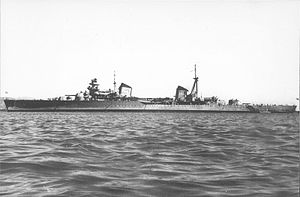 Side view of Molotov
| |
| History | |
|---|---|
| Name | Molotov |
| Namesake | Vyacheslav Molotov[1] |
| Builder | Marti South, Nikolayev |
| Laid down | 14 January 1937 |
| Launched | 4 December 1939 |
| Commissioned | 14 January 1941 |
| Renamed | Slava (Glory) 3 August 1957 |
| Reclassified | 3 August 1961, as training ship |
| Refit | 1952–28 January 1955 |
| Fate | Sold for scrap, 4 April 1972 |
| General characteristics (Project 26bis) | |
| Class and type | Kirov-class cruiser |
| Displacement | |
| Length | 191.4 m (627 ft 11 in) |
| Beam | 17.66 m (57 ft 11 in) |
| Draft | 6.3 m (20 ft 8 in) (full load) |
| Installed power | |
| Propulsion | 2 shafts, 2 geared turbines |
| Speed | 36.72 knots (68.01 km/h; 42.26 mph) (on trials) |
| Endurance | 4,220 nmi (7,820 km; 4,860 mi) at 18 knots (33 km/h; 21 mph) |
| Complement | 963 |
| Sensors and processing systems |
|
| Armament |
|
| Armor |
|
| Aircraft carried | 2 × KOR-2 seaplanes |
| Aviation facilities | 1 ZK-1 catapult |
Molotov (Russian: Молотов) was a Project 26bis Kirov-class cruiser of the Soviet Navy that served during World War II and into the Cold War. She supported Soviet troops during the Siege of Sevastopol, the Kerch-Feodosiya Operation and the amphibious landings at Novorossiysk at the end of January 1943.
The ship was extensively modernized between 1952 and 1955. She was renamed Slava (Russian: Слава, Glory) in 1957 after Vyacheslav Molotov fell out of favour. Slava was reclassified as a training ship in 1961 before being sold for scrap in 1972.
- ^ Yakubov and Worth, p. 93